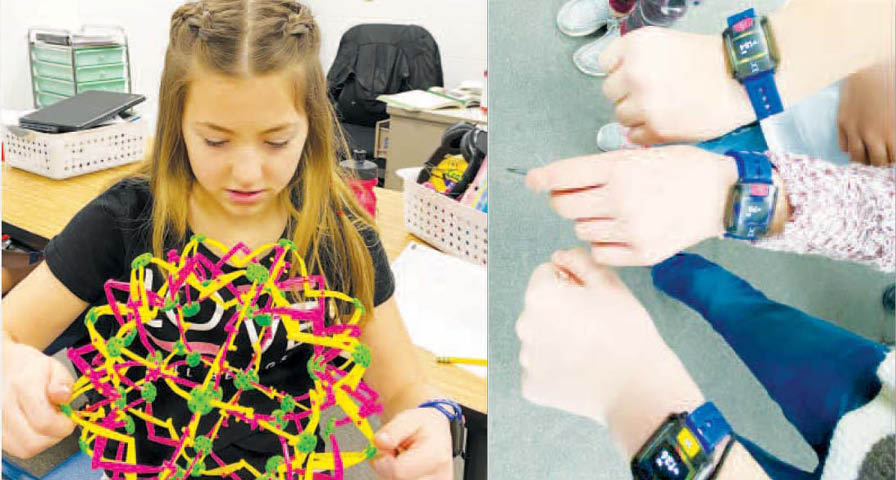Originally published Feb. 1, 2022 in the Braham Journal.
By Hope Murray
Since the start of the pandemic, teachers and school social workers have been contending with questions surrounding the mental health of students. Such is the case at Braham Area Schools, where the counseling department has seen an increase in students with anxiety and depression, and with difficulty managing those emotions.
But Jonelle Klemz, school social worker, is doing some “amazing things at Braham Elementary to proactively address student’s mental health.”
In the spring of 2021, the Grandy Lions Club awarded the district a grant to purchase Interactive Health Technology heart rate monitors, developed by IHT Spirit System. Klemz is using the monitors to show students the link between their heart rates, breathing, and their physical and emotional health.
“When I went to the (Grandy) Lions and I gave them my presentation, I was asking for one set; they come in sets of 28,” Klemz said. “But after the presentation, the Lions agreed to pay for two more, so I have enough for (students in) a classroom and a half.”
Each morning, one classroom of students in grades first through sixth has the opportunity to strap a “bomber band,” as Klemz calls them, on their wrists and wear them throughout the day. At the start of the school day, she gives students a lesson on social-emotional health. Finally, at the end of the school day, Klemz meets with each individual student to discuss the data the heart monitors collected.
“I want them to see how their breathing affects their stress levels,” Klemz said. “It’s not enough for me to just tell them that controlling their breathing will make themselves feel better; I can show them through the data.”
Each student is able to get a visual representation of their heart rates, and students can see from the data when they were exerting themselves physically or if their stress levels were high prior to a test. The bands also change colors as heart rates begin to spike, offering a visual representation of a student’s exertion or heightened emotion.
When the bomber band shows a blue color, it means the student’s heart is at a normal rate, such as when they are doing low-impact activities such as yoga or if their mood is calm, tired or even sad. Yellow indicates that their heart rates are becoming elevated, such as when they are doing an easy jog or they are feeling excited, nervous or embarrassed. When a student’s band reads red, their heart rate is high, demonstrating that they are playing soccer or having a brisk run in PE class. However, the red zone can also be a warning sign for a student who is beginning to feel angry or terrified.
Klemz’s classroom lessons involve giving students methods to slow their breathing, lower their heart rates and regulate their heightened emotions. The student can use the tools Klemz is teaching to calm themselves, whether through deep breathing exercises or taking a walk around the hallway, and they can see the band’s color go from red to yellow and finally to blue.
Having students take control of their social emotional health and try to de-escalate themselves before they become too anxious is paramount these days, Klemz said. Since the start of the pandemic in 2020, the Braham Schools Counseling Department has seen an increase in referrals at all grade levels with anxiety, depression and managing emotions, she said.
“I believe (the rise in referrals) is due to all of society experiencing these same issues as we continue to deal with the stress of a pandemic,” she added.
It was a news story on NBC’s Today show that first caught Klemz’s attention. The story showed how the heart monitors worked, and illustrated how they can be used in the classroom. Klemz was drawn to the information on studies from the American Psychological Association that showed that kids who better handle their emotions do better in school and are better able to cope with daily stresses without their resorting to anger, outbursts or even stress eating.
“We have students not only dealing with a pandemic but with health issues in the family, divorce, poverty,” Klemz said.
IHT seemed like a perfect fit for her students in the Braham district, and she wanted them to start young since small children are still developing and can adapt better to learning what are, essentially, lifelong skills. She has received nothing but raves from school administration and classroom teachers.
“I love when I am leaving a classroom (at the end of the day) and the teacher and students continue to discuss what they are learning about regulating themselves,” Klemz said.
Her hope is that students learn not only the methods to calm themselves when they become anxious but also to communicate when they are bothered by something that may be triggering them. She wants them to have these skills, especially because as they get older, they will have to contend with juggling school work, extracurriculars, employment and the increase of social media activities, which can often accelerate anxiety and depression in kids.
The goal is for students to be able to regulate their heart rates and breathing without relying on the band. As they “get to know themselves better,” Klemz said, they “learn to manage their emotions and ultimately feel happier.”
Boost Student Wellness with the IHT ZONE heart rate monitor:


